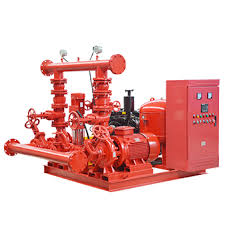When choices are limited for storing fire pump equipment indoors, pump houses and aluminum paneled pump enclosures can offer external solutions.
Fire pumps provide water pressure needed to supply sprinkler systems located inside large high-rise buildings or warehouses to charge the sprinkler system during an emergency situation. Booster pumps help make up for any lack of pressure in the local water supply, water tank or other water sources provided and can be located inside or outside of the building. 
A common practice is to store fire pump systems inside the primary building which provides a number of advantages. For starters, the building itself provides protection from weather and the elements and would most likely include a designated pump room that can easily be accessed for maintenance and testing of equipment. The potential downside of storing pump equipment inside the primary building is that it may take up valuable retail space.
When there’s not enough room inside the warehouse building or the retail floor space is too valuable to give up, locating fire pumps outside the primary building in a “pump house” is the only other alternative. So what options are available to store fire pump equipment outside of the primary building?
Pump houses
One option is to store the fire pump system inside a large pre-fabricated building called a “pump house.” They’re typically located near the primary building. Pump house manufacturers promote them as a long-term solution in various climates.
Some permanent pump house manufacturers also manufacture the pumps. This should mean they're experts when it comes to their own equipment and may have an advantage over a manufacturer that doesn't also make pumps.
Pump houses are also pre-fabricated and come assembled. This eliminates the need to assemble on-site. They can be customized with different doors, light, climate control and finish options.
Modular pump enclosures
An alternative to this style of building is a modular panel design enclosure. Aluminum-paneled enclosures are constructed from individual insulated panels that are quickly assembled on-site and can be easily disassembled if needed. They are not considered to be a permanent structure and therefore there is no need for permits.
Since they are made up of panels, each panel can easily be swapped out for a door or access panel. This allows for efficient and safe maintenance and repairs for the equipment. It also means that a single panel can be shipped in to replace a damaged one.
Speaking of replacements, many modular enclosures have removable roofs so that the equipment inside can be replaced. The enclosures can be secured to concrete slabs or portable skids to allow for transportation from project site to project site. For aesthetics, they can be colored or even wrapped.
Aluminum Enclosures For Fire Pumps
Aluminum is very easy to work with and can be customized to meet nearly any specific size requirement. Of course there are many brands, sizes, and layouts of fire pump applications, and using a modular design makes it easy to size the enclosure specifically for the equipment's needs.
Because it's so easy to work with, aluminum also allows for adding piping penetrations on-site. Fans, louvers, windows and more can be added. If pricing is swaying your decision between these two options, you may be pleased to learn that paneled enclosures are shipped flat in a box that significantly reduces freight costs and damage risks.
Protecting fire pump equipment from weather and the elements is a critical feature of a pump enclosure. Pump enclosures contain sensitive equipment such as control panels and electronics that don’t like to get wet or covered in snow. You’ll want one capable of standing up to wind and rain and able to handle heavy snow, too.
If you’re in the market for a fire pump cover, our guide: “How to Design and Buy a Pump Enclosure” will show you how. This checklist will walk you through all of the necessary steps.





